Nursing Assignment 4: Mental Health Interventions and Research
VerifiedAdded on 2020/03/04
|8
|1286
|65
Report
AI Summary
This nursing assignment delves into the critical aspects of mental health care, specifically focusing on suicide prevention and the treatment of depression. It examines primary, secondary, and tertiary nursing interventions for self-harm and suicide, highlighting the role of organizations like Suicide Prevention Australia and Lifeline. The assignment also emphasizes the importance of collaborating with families of mental health service users, addressing the challenges and stigmas they face. Furthermore, it reviews recent research evidence on the treatment of depressed patients, including collaborative care models and telephone-based services. The report underscores the significance of trained nurses, medication management, self-help information, and symptom assessment in providing effective care. References to key research papers and organizations support the findings, providing a comprehensive overview of current practices and challenges in the field of mental health nursing.
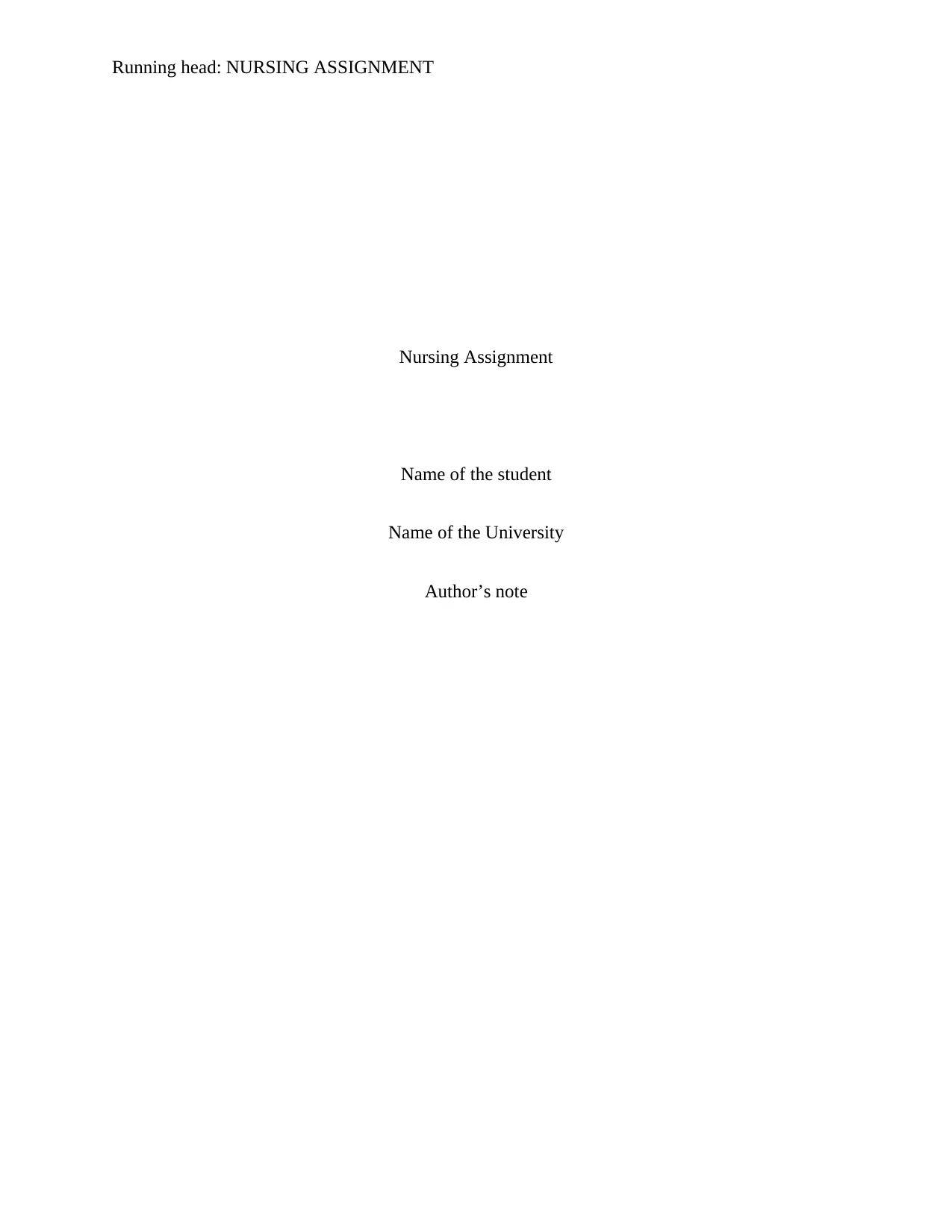
Running head: NURSING ASSIGNMENT
Nursing Assignment
Name of the student
Name of the University
Author’s note
Nursing Assignment
Name of the student
Name of the University
Author’s note
Paraphrase This Document
Need a fresh take? Get an instant paraphrase of this document with our AI Paraphraser
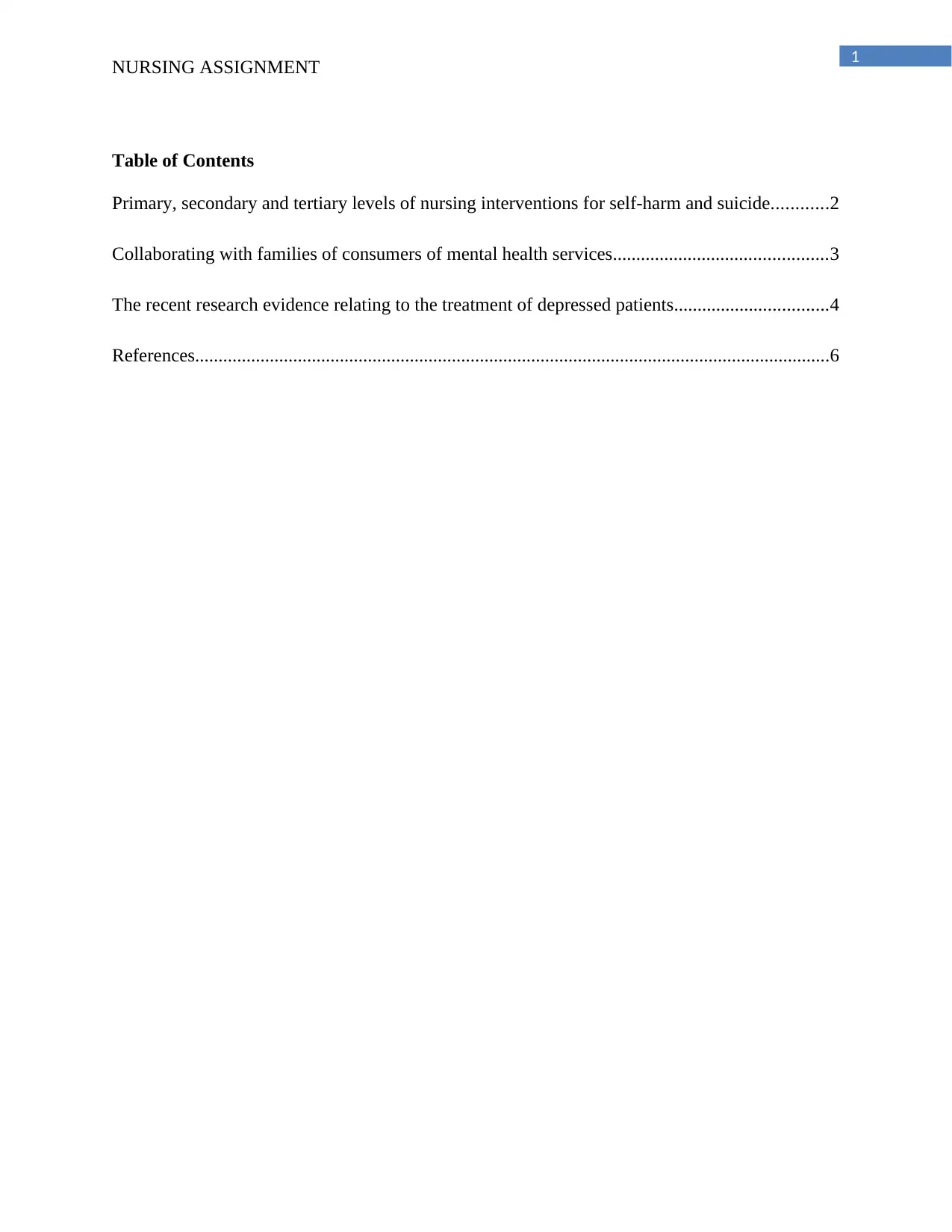
1
NURSING ASSIGNMENT
Table of Contents
Primary, secondary and tertiary levels of nursing interventions for self-harm and suicide............2
Collaborating with families of consumers of mental health services..............................................3
The recent research evidence relating to the treatment of depressed patients.................................4
References........................................................................................................................................6
NURSING ASSIGNMENT
Table of Contents
Primary, secondary and tertiary levels of nursing interventions for self-harm and suicide............2
Collaborating with families of consumers of mental health services..............................................3
The recent research evidence relating to the treatment of depressed patients.................................4
References........................................................................................................................................6
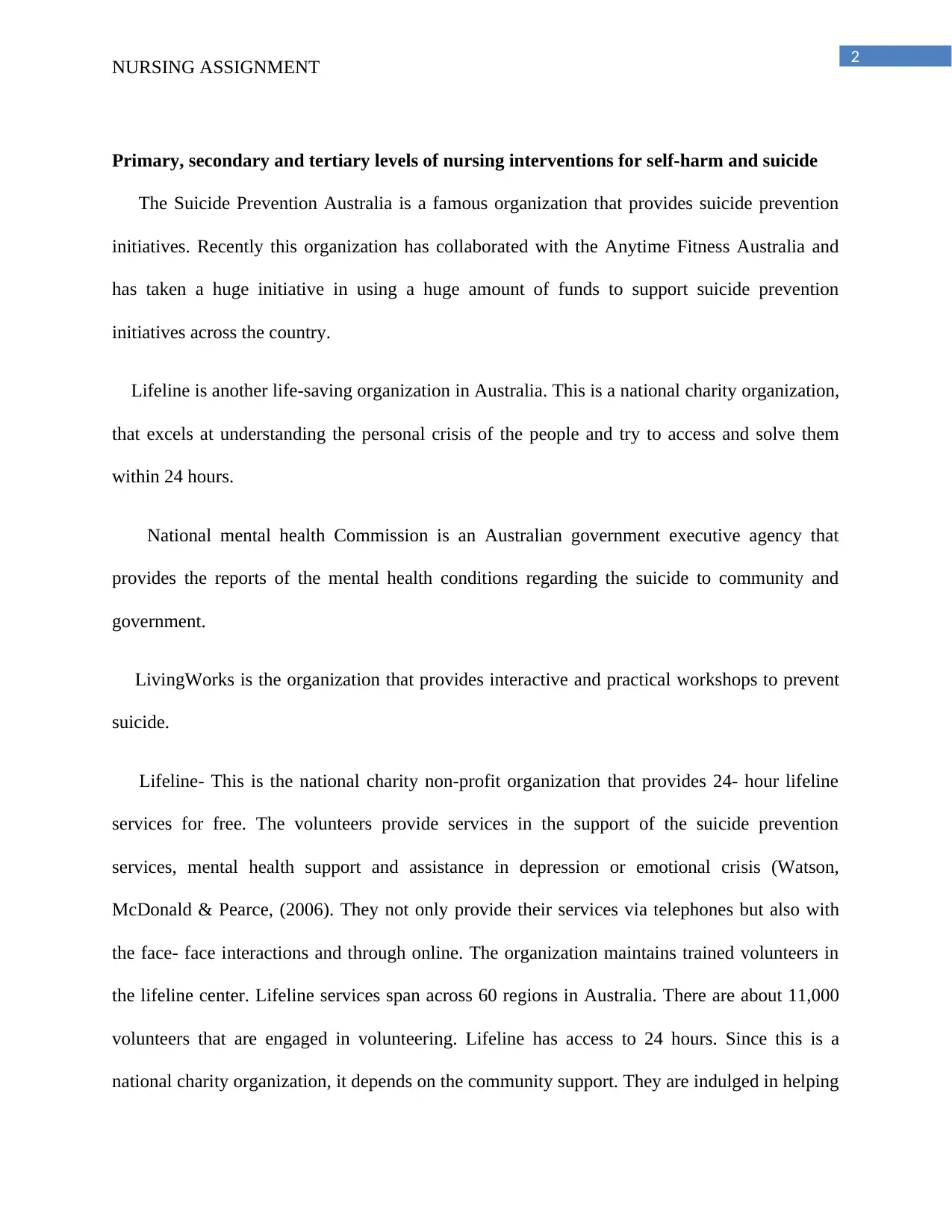
2
NURSING ASSIGNMENT
Primary, secondary and tertiary levels of nursing interventions for self-harm and suicide
The Suicide Prevention Australia is a famous organization that provides suicide prevention
initiatives. Recently this organization has collaborated with the Anytime Fitness Australia and
has taken a huge initiative in using a huge amount of funds to support suicide prevention
initiatives across the country.
Lifeline is another life-saving organization in Australia. This is a national charity organization,
that excels at understanding the personal crisis of the people and try to access and solve them
within 24 hours.
National mental health Commission is an Australian government executive agency that
provides the reports of the mental health conditions regarding the suicide to community and
government.
LivingWorks is the organization that provides interactive and practical workshops to prevent
suicide.
Lifeline- This is the national charity non-profit organization that provides 24- hour lifeline
services for free. The volunteers provide services in the support of the suicide prevention
services, mental health support and assistance in depression or emotional crisis (Watson,
McDonald & Pearce, (2006). They not only provide their services via telephones but also with
the face- face interactions and through online. The organization maintains trained volunteers in
the lifeline center. Lifeline services span across 60 regions in Australia. There are about 11,000
volunteers that are engaged in volunteering. Lifeline has access to 24 hours. Since this is a
national charity organization, it depends on the community support. They are indulged in helping
NURSING ASSIGNMENT
Primary, secondary and tertiary levels of nursing interventions for self-harm and suicide
The Suicide Prevention Australia is a famous organization that provides suicide prevention
initiatives. Recently this organization has collaborated with the Anytime Fitness Australia and
has taken a huge initiative in using a huge amount of funds to support suicide prevention
initiatives across the country.
Lifeline is another life-saving organization in Australia. This is a national charity organization,
that excels at understanding the personal crisis of the people and try to access and solve them
within 24 hours.
National mental health Commission is an Australian government executive agency that
provides the reports of the mental health conditions regarding the suicide to community and
government.
LivingWorks is the organization that provides interactive and practical workshops to prevent
suicide.
Lifeline- This is the national charity non-profit organization that provides 24- hour lifeline
services for free. The volunteers provide services in the support of the suicide prevention
services, mental health support and assistance in depression or emotional crisis (Watson,
McDonald & Pearce, (2006). They not only provide their services via telephones but also with
the face- face interactions and through online. The organization maintains trained volunteers in
the lifeline center. Lifeline services span across 60 regions in Australia. There are about 11,000
volunteers that are engaged in volunteering. Lifeline has access to 24 hours. Since this is a
national charity organization, it depends on the community support. They are indulged in helping
⊘ This is a preview!⊘
Do you want full access?
Subscribe today to unlock all pages.

Trusted by 1+ million students worldwide
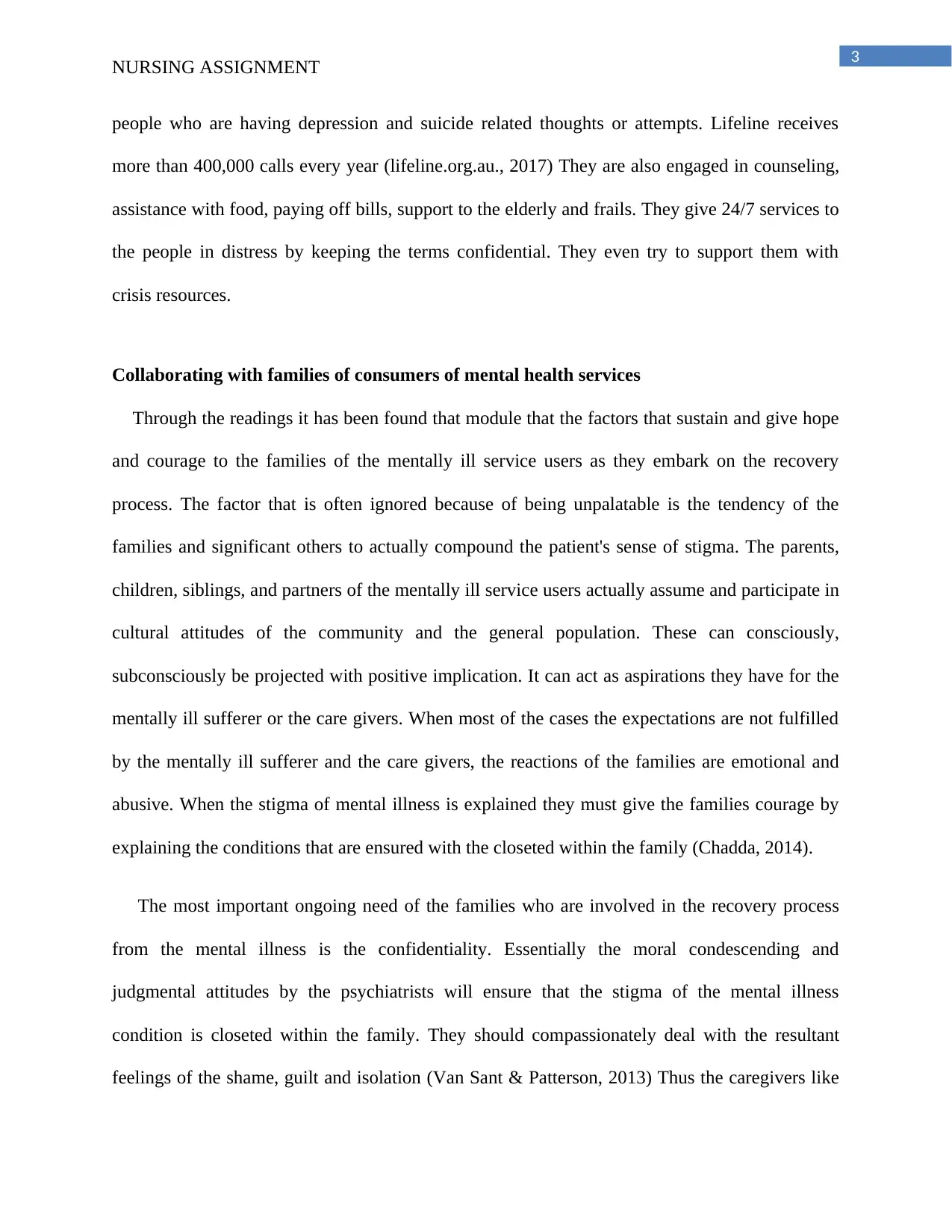
3
NURSING ASSIGNMENT
people who are having depression and suicide related thoughts or attempts. Lifeline receives
more than 400,000 calls every year (lifeline.org.au., 2017) They are also engaged in counseling,
assistance with food, paying off bills, support to the elderly and frails. They give 24/7 services to
the people in distress by keeping the terms confidential. They even try to support them with
crisis resources.
Collaborating with families of consumers of mental health services
Through the readings it has been found that module that the factors that sustain and give hope
and courage to the families of the mentally ill service users as they embark on the recovery
process. The factor that is often ignored because of being unpalatable is the tendency of the
families and significant others to actually compound the patient's sense of stigma. The parents,
children, siblings, and partners of the mentally ill service users actually assume and participate in
cultural attitudes of the community and the general population. These can consciously,
subconsciously be projected with positive implication. It can act as aspirations they have for the
mentally ill sufferer or the care givers. When most of the cases the expectations are not fulfilled
by the mentally ill sufferer and the care givers, the reactions of the families are emotional and
abusive. When the stigma of mental illness is explained they must give the families courage by
explaining the conditions that are ensured with the closeted within the family (Chadda, 2014).
The most important ongoing need of the families who are involved in the recovery process
from the mental illness is the confidentiality. Essentially the moral condescending and
judgmental attitudes by the psychiatrists will ensure that the stigma of the mental illness
condition is closeted within the family. They should compassionately deal with the resultant
feelings of the shame, guilt and isolation (Van Sant & Patterson, 2013) Thus the caregivers like
NURSING ASSIGNMENT
people who are having depression and suicide related thoughts or attempts. Lifeline receives
more than 400,000 calls every year (lifeline.org.au., 2017) They are also engaged in counseling,
assistance with food, paying off bills, support to the elderly and frails. They give 24/7 services to
the people in distress by keeping the terms confidential. They even try to support them with
crisis resources.
Collaborating with families of consumers of mental health services
Through the readings it has been found that module that the factors that sustain and give hope
and courage to the families of the mentally ill service users as they embark on the recovery
process. The factor that is often ignored because of being unpalatable is the tendency of the
families and significant others to actually compound the patient's sense of stigma. The parents,
children, siblings, and partners of the mentally ill service users actually assume and participate in
cultural attitudes of the community and the general population. These can consciously,
subconsciously be projected with positive implication. It can act as aspirations they have for the
mentally ill sufferer or the care givers. When most of the cases the expectations are not fulfilled
by the mentally ill sufferer and the care givers, the reactions of the families are emotional and
abusive. When the stigma of mental illness is explained they must give the families courage by
explaining the conditions that are ensured with the closeted within the family (Chadda, 2014).
The most important ongoing need of the families who are involved in the recovery process
from the mental illness is the confidentiality. Essentially the moral condescending and
judgmental attitudes by the psychiatrists will ensure that the stigma of the mental illness
condition is closeted within the family. They should compassionately deal with the resultant
feelings of the shame, guilt and isolation (Van Sant & Patterson, 2013) Thus the caregivers like
Paraphrase This Document
Need a fresh take? Get an instant paraphrase of this document with our AI Paraphraser
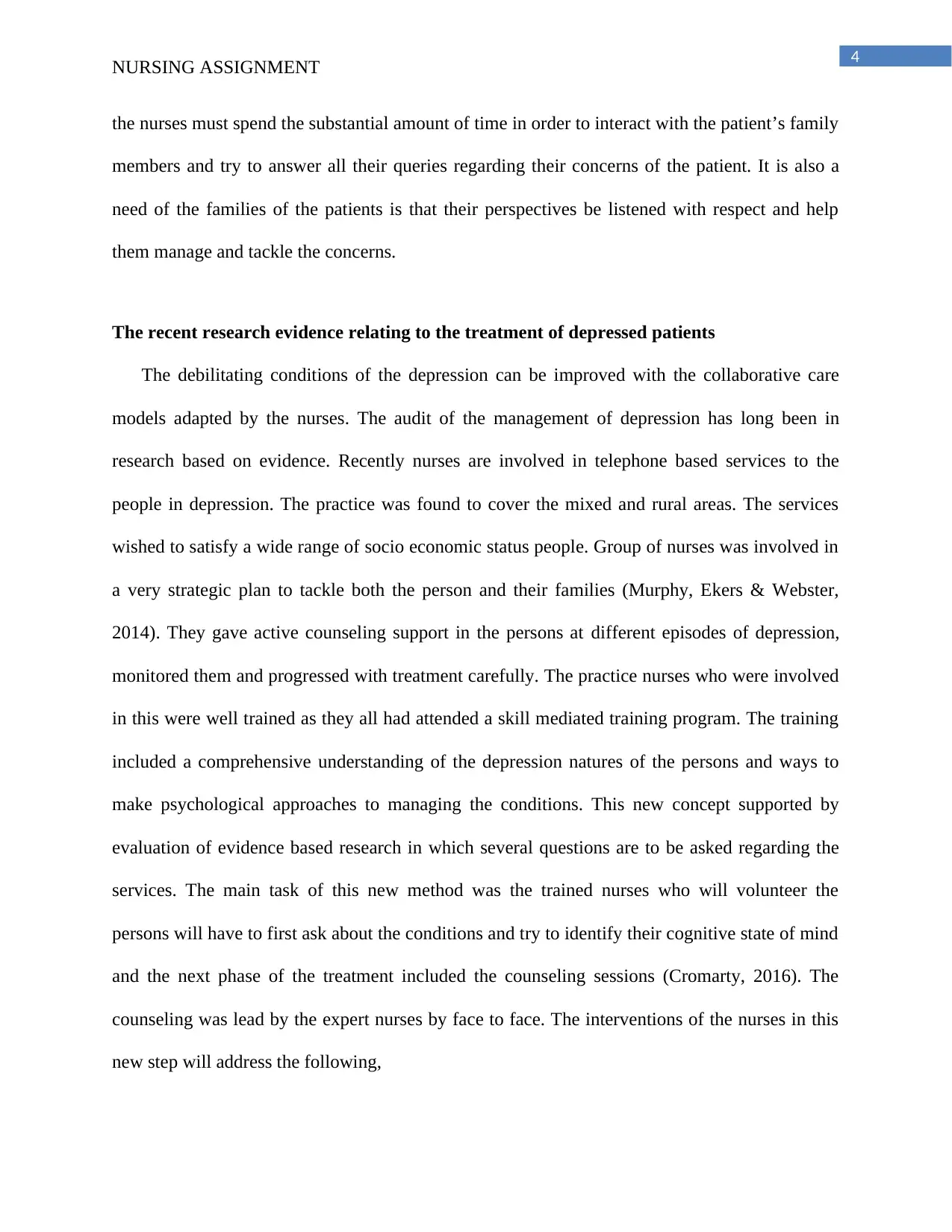
4
NURSING ASSIGNMENT
the nurses must spend the substantial amount of time in order to interact with the patient’s family
members and try to answer all their queries regarding their concerns of the patient. It is also a
need of the families of the patients is that their perspectives be listened with respect and help
them manage and tackle the concerns.
The recent research evidence relating to the treatment of depressed patients
The debilitating conditions of the depression can be improved with the collaborative care
models adapted by the nurses. The audit of the management of depression has long been in
research based on evidence. Recently nurses are involved in telephone based services to the
people in depression. The practice was found to cover the mixed and rural areas. The services
wished to satisfy a wide range of socio economic status people. Group of nurses was involved in
a very strategic plan to tackle both the person and their families (Murphy, Ekers & Webster,
2014). They gave active counseling support in the persons at different episodes of depression,
monitored them and progressed with treatment carefully. The practice nurses who were involved
in this were well trained as they all had attended a skill mediated training program. The training
included a comprehensive understanding of the depression natures of the persons and ways to
make psychological approaches to managing the conditions. This new concept supported by
evaluation of evidence based research in which several questions are to be asked regarding the
services. The main task of this new method was the trained nurses who will volunteer the
persons will have to first ask about the conditions and try to identify their cognitive state of mind
and the next phase of the treatment included the counseling sessions (Cromarty, 2016). The
counseling was lead by the expert nurses by face to face. The interventions of the nurses in this
new step will address the following,
NURSING ASSIGNMENT
the nurses must spend the substantial amount of time in order to interact with the patient’s family
members and try to answer all their queries regarding their concerns of the patient. It is also a
need of the families of the patients is that their perspectives be listened with respect and help
them manage and tackle the concerns.
The recent research evidence relating to the treatment of depressed patients
The debilitating conditions of the depression can be improved with the collaborative care
models adapted by the nurses. The audit of the management of depression has long been in
research based on evidence. Recently nurses are involved in telephone based services to the
people in depression. The practice was found to cover the mixed and rural areas. The services
wished to satisfy a wide range of socio economic status people. Group of nurses was involved in
a very strategic plan to tackle both the person and their families (Murphy, Ekers & Webster,
2014). They gave active counseling support in the persons at different episodes of depression,
monitored them and progressed with treatment carefully. The practice nurses who were involved
in this were well trained as they all had attended a skill mediated training program. The training
included a comprehensive understanding of the depression natures of the persons and ways to
make psychological approaches to managing the conditions. This new concept supported by
evaluation of evidence based research in which several questions are to be asked regarding the
services. The main task of this new method was the trained nurses who will volunteer the
persons will have to first ask about the conditions and try to identify their cognitive state of mind
and the next phase of the treatment included the counseling sessions (Cromarty, 2016). The
counseling was lead by the expert nurses by face to face. The interventions of the nurses in this
new step will address the following,
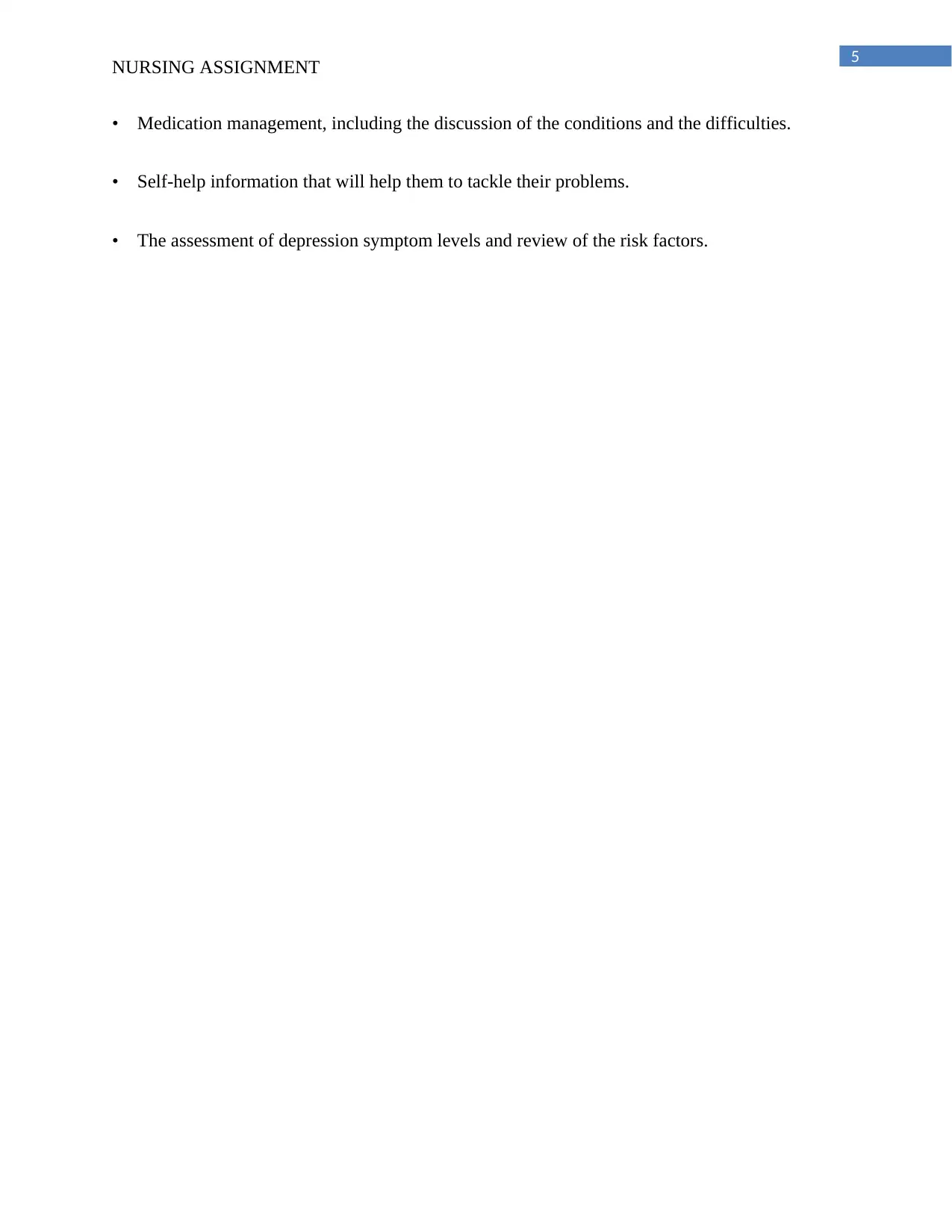
5
NURSING ASSIGNMENT
• Medication management, including the discussion of the conditions and the difficulties.
• Self-help information that will help them to tackle their problems.
• The assessment of depression symptom levels and review of the risk factors.
NURSING ASSIGNMENT
• Medication management, including the discussion of the conditions and the difficulties.
• Self-help information that will help them to tackle their problems.
• The assessment of depression symptom levels and review of the risk factors.
⊘ This is a preview!⊘
Do you want full access?
Subscribe today to unlock all pages.

Trusted by 1+ million students worldwide
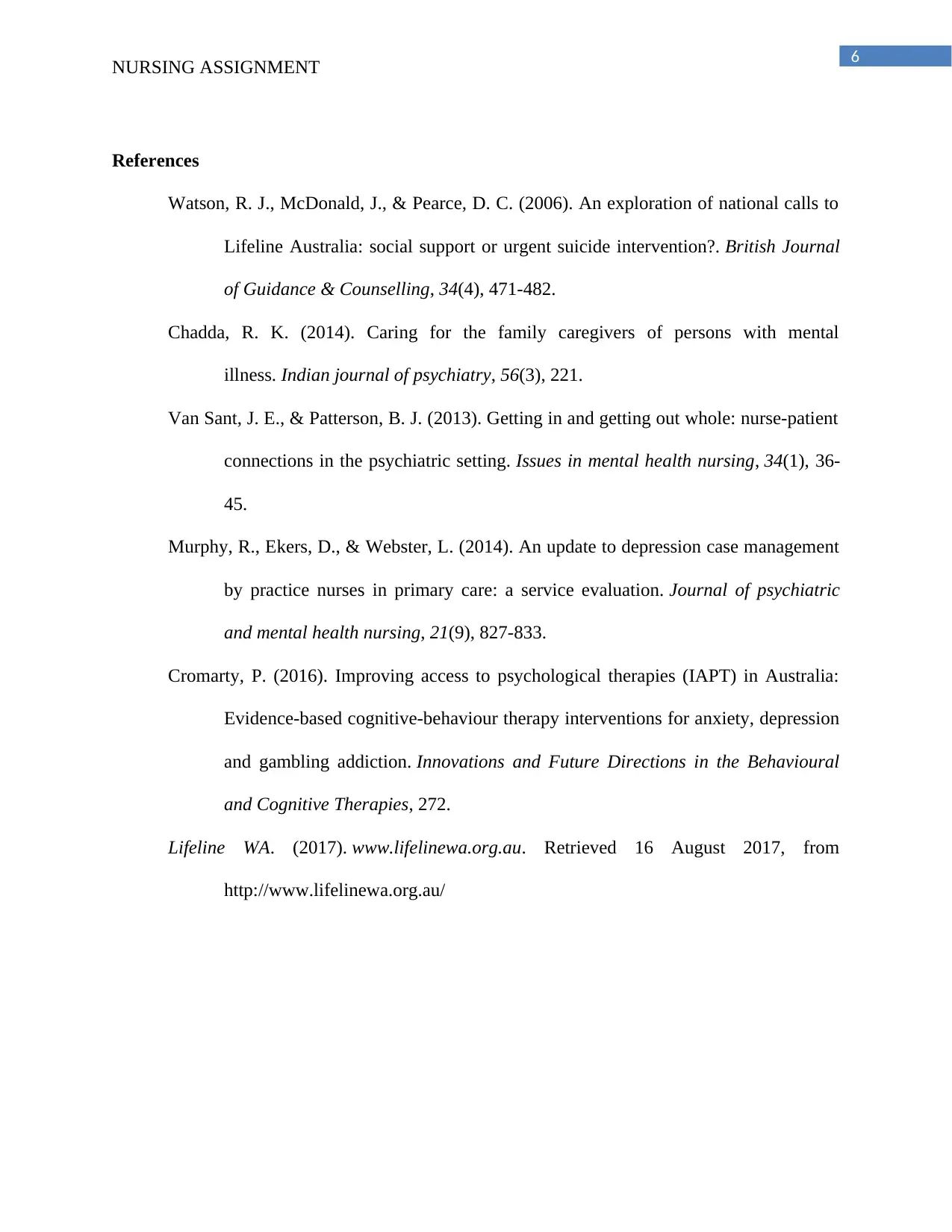
6
NURSING ASSIGNMENT
References
Watson, R. J., McDonald, J., & Pearce, D. C. (2006). An exploration of national calls to
Lifeline Australia: social support or urgent suicide intervention?. British Journal
of Guidance & Counselling, 34(4), 471-482.
Chadda, R. K. (2014). Caring for the family caregivers of persons with mental
illness. Indian journal of psychiatry, 56(3), 221.
Van Sant, J. E., & Patterson, B. J. (2013). Getting in and getting out whole: nurse-patient
connections in the psychiatric setting. Issues in mental health nursing, 34(1), 36-
45.
Murphy, R., Ekers, D., & Webster, L. (2014). An update to depression case management
by practice nurses in primary care: a service evaluation. Journal of psychiatric
and mental health nursing, 21(9), 827-833.
Cromarty, P. (2016). Improving access to psychological therapies (IAPT) in Australia:
Evidence-based cognitive-behaviour therapy interventions for anxiety, depression
and gambling addiction. Innovations and Future Directions in the Behavioural
and Cognitive Therapies, 272.
Lifeline WA. (2017). www.lifelinewa.org.au. Retrieved 16 August 2017, from
http://www.lifelinewa.org.au/
NURSING ASSIGNMENT
References
Watson, R. J., McDonald, J., & Pearce, D. C. (2006). An exploration of national calls to
Lifeline Australia: social support or urgent suicide intervention?. British Journal
of Guidance & Counselling, 34(4), 471-482.
Chadda, R. K. (2014). Caring for the family caregivers of persons with mental
illness. Indian journal of psychiatry, 56(3), 221.
Van Sant, J. E., & Patterson, B. J. (2013). Getting in and getting out whole: nurse-patient
connections in the psychiatric setting. Issues in mental health nursing, 34(1), 36-
45.
Murphy, R., Ekers, D., & Webster, L. (2014). An update to depression case management
by practice nurses in primary care: a service evaluation. Journal of psychiatric
and mental health nursing, 21(9), 827-833.
Cromarty, P. (2016). Improving access to psychological therapies (IAPT) in Australia:
Evidence-based cognitive-behaviour therapy interventions for anxiety, depression
and gambling addiction. Innovations and Future Directions in the Behavioural
and Cognitive Therapies, 272.
Lifeline WA. (2017). www.lifelinewa.org.au. Retrieved 16 August 2017, from
http://www.lifelinewa.org.au/
Paraphrase This Document
Need a fresh take? Get an instant paraphrase of this document with our AI Paraphraser

7
NURSING ASSIGNMENT
NURSING ASSIGNMENT
1 out of 8
Related Documents
Your All-in-One AI-Powered Toolkit for Academic Success.
+13062052269
info@desklib.com
Available 24*7 on WhatsApp / Email
![[object Object]](/_next/static/media/star-bottom.7253800d.svg)
Unlock your academic potential
Copyright © 2020–2025 A2Z Services. All Rights Reserved. Developed and managed by ZUCOL.





